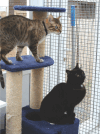Environmental enrichment: practical strategies for improving feline welfare
- PMID: 19857853
- PMCID: PMC11383019
- DOI: 10.1016/j.jfms.2009.09.011
Environmental enrichment: practical strategies for improving feline welfare
Abstract
Practical relevance: The clinical application of evidence-based enrichment strategies for the domestic cat housed in a variety of confined environments, ranging from the veterinary cage to the domestic home, is of particular importance - both in relation to providing opportunity for appropriate feline behaviour, and in the prevention and treatment of behavioural and associated health problems (eg, feline lower urinary tract disease associated with negative emotional states such as generalised anxiety). Environmental enrichment has gained particular relevance in the light of current animal welfare legislation. For example, in the UK, the Animal Welfare Act 2006 stipulates that owners/keepers have a duty of care to their animal(s) that includes allowing the animal to exhibit normal behaviour patterns.
Evidence base: Research into environmental enrichment as a means of improving animal welfare is still very much in its infancy, particularly in relation to the domestic cat. Thus, evidence-based studies are somewhat sparse and more are needed to validate current recommended enrichment practices.
Audience: This article aims to assist general veterinary practitioners to recognise how cats respond to confinement, and to understand what constitutes environmental enrichment, to help them implement or advise on appropriate enrichment strategies for cats confined in a hospital cage, home environment (particularly an indoor-only home), or cattery or rescue shelter, based on published evidence to date.
Figures










References
-
- Chamove AS. Environmental enrichment: a review. Anim Technol 1989; 40: 155–78.
-
- Newberry RC. Environmental enrichment: increasing the biological relevance of captive environments. Appl Anim Behav Sci 1995; 44: 229–43.
-
- Shepherdson DJ. Tracing the path of environmental enrichment in zoos. In: Shepherdson DJ, Mellen JD, Hutchins M, eds. Second nature: environmental enrichment for captive animals. Washington DC: Smithsonian Institution Press, 1998: 1–12.
-
- Young R. Environmental enrichment for captive animals. Universities Federation for Animal Welfare (UFAW) Series, Oxford: Blackwell Publishing, 2003.
-
- Smith AL, Corrow DJ. Modifications to husbandry and housing conditions of laboratory rodents for improved well-being. ILAR J 2005; 46: 140–47. - PubMed
Publication types
MeSH terms
LinkOut - more resources
Full Text Sources
Miscellaneous

